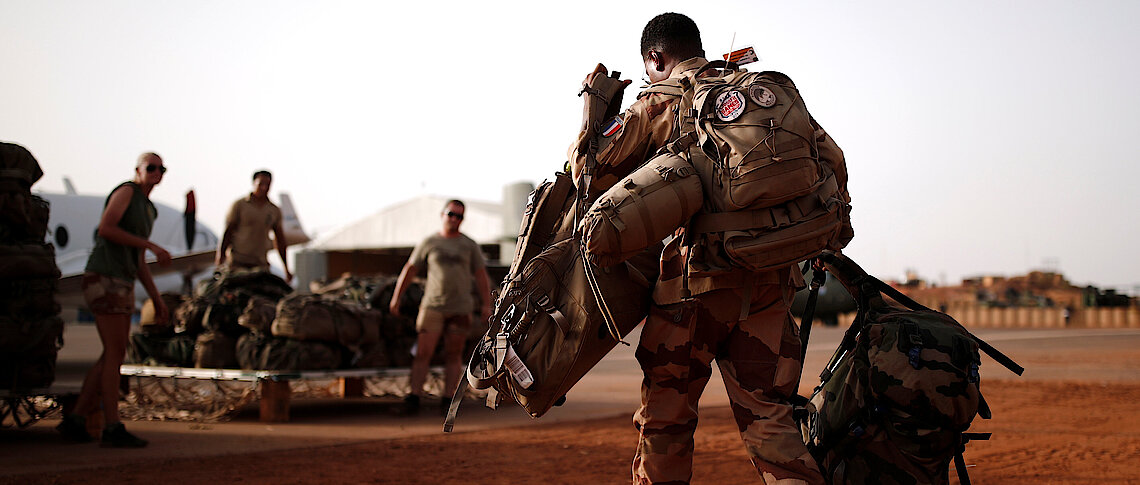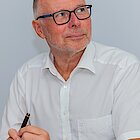Read this article in German.
In a highly symbolic ceremony on 13 January 2020, prior to the G5 Sahel summit in Pau, French President Emmanuel Macron and the presidents of Burkina Faso, Mali, Mauritania, Niger and Chad, laid a wreath for the 13 French soldiers who lost their lives in a helicopter crash in Mali last November. 4,500 of their comrades are currently stationed in these countries as part of Operation Barkhane in the face of loud protests from large parts of the population and the resistance of a growing number of intellectuals. They are accusing the French foreign intervention of imperialist motives on the one hand, and ineffectiveness on the other — and even of fuelling the conflicts.
In Burkina Faso, which was involved in the 2016 operation, the security situation has been deteriorating ever since. Following the simultaneous attack on the Burkinabe army headquarters and the French embassy in Ouagadougou in March 2018, jihadist attacks have multiplied, especially in the regions bordering Mali and Niger. The number of victims is estimated to be more than 400 civilians and around 200 Burkinabe soldiers.
The attacks on the population reached a tragic high point with the Arbinda massacre near the Mali border in which 35 people, including 31 women, were killed on Christmas Eve of 2019. The security forces are no longer in control in almost half of the country’s territory. The number of internally displaced persons has risen rapidly to over a quarter million Burkinabe. Over one thousand schools were closed and hundreds of health care units are no longer offering services. Is Burkina Faso, the ‘land of the upright’, at the edge of the abyss?
How Burkina Faso got drawn into it
The threat of armed underground movements in the Sahel was triggered by the overthrow of Libyan dictator Muammar Gaddafi in 2011. When forced to leave Libya, thousands of former soldiers from the Sahel took their rifles and joined local political groups in their home countries. The epicentre of the conflict was northern Mali, where Tuareg rebels, allied with violent extremists, proclaimed the independent state of Azawad.
The focus on military or paramilitary containment of the threat to the rural population falls short, especially since the national, regional and international interventions have so far had little effect.
Until the fall of President Blaise Compaoré in 2014, Burkina Faso played a rather neutral or mediating role and was seen as a blank spot on the West African map of terrorism. Starting in 2015, Burkinabe foreign policy under the government of Roch Marc Kaboré was oriented toward its neighbours Mali and Niger, which were more severely afflicted by jihadism, and the international alliance against the self-anointed ‘warriors of God’. In doing so, Burkina Faso found itself in the line of fire. Moreover, it increasingly became a place of refuge for extremists under pressure.
The country has consequently become a hotspot for bloody clashes with Islamist violent extremists in the Sahel. And compared to other states in the region, it is the least prepared for it. Its army, a total of 12,000 poorly trained soldiers, is completely overwhelmed by the asymmetrical warfare imposed on it by only 600 Ansar ul Islam fighters. The dissolution of the presidential guard, which until 2014 reported directly to former head of state Blaise Compaoré, further worsened the situation, since this unit of 1,300 elite troops was the only one trained to combat insurgency and terrorism. As a result the accumulated knowledge, along with a large network of local informants, was lost, partially leading to the weakening of the army.
A dubious reliance on paramilitary forces
Faced with this emergency, the government has launched so-called paramilitary ‘self-defence committees’. They rely on local groups called ‘Koglwéogo’ (‘Protectors of the bush’) that — because of the lack of the state’s presence in rural regions far from the capital — not only perform police duties but also partly function as local jurisdiction. Supported by tradespeople based in the villages, partly paid for by the mayors and promoted by local politicians, they enjoy relative autonomy. However, apart from their successes in combating crime and defending villages against armed attacks, they are also blamed for massive human rights violations such as torture and massacres of people from the Fula ethnic group.
Assessments differ as to whether the state’s acknowledgement of its own powerlessness ultimately leads to local militia actions over the long term that can no longer be controlled. Even under the government of charismatic President Thomas Sankara, local revolutionary committees existed that were supposed to fight against restorative tendencies and increase security in the villages. In many places, however, the committees themselves committed acts of violence or were open to following orders from non-state actors. Several attempts were then made to limit their influence, although to no discernible effect.
The focus on military or paramilitary containment of the threat to the rural population falls short, especially since the national, regional and international interventions have so far had little effect. Ansar ul Islam and other violent movements can spread more or less unhindered because they are successfully recruiting new fighters despite the high losses of human lives.
The discussion revolves around military approaches, especially in France and its European allies, but also under the presidents of the affected Sahel countries.
A study by the United Nations Development Programme shows that there are many young, frustrated men living in the neglected periphery of the country who have not been offered any prospects for the future. Without any economically viable opportunities, without the possibility to feed a family and disappointed by a governmental authority that can provide neither security nor basic services – but instead enriches itself and deprives its citizens of rights – this younger generation gives in to promises made by extremists.
A long-term regional strategy
In addition to military action against terrorism, Burkina Faso needs a long-term economic, political and social strategy — and the same holds true for its neighbouring countries, including those to the south. In Burkina Faso itself, one of the poorest countries in the world, special efforts are required to open up a future for young people. This includes expanding physical infrastructure, providing state services – especially the schools and training centres attacked by jihadists – but also promoting employment in rural areas.
Such programs are difficult to implement in a context characterised by violence and fatal assaults and require commitment beyond the usual three-year cycle of development projects. They need to be accompanied by quick-acting measures from the humanitarian aid toolbox – for example, cash for work activities. Targeted support for minorities, such as semi-nomads, ranchers or ethnic groups is particularly important in the Sahel. Here too, government agencies and security forces play a crucial role in de-escalating conflicts because minorities are often exposed to large-scale attacks by the national armed forces.
The discussion revolves around military approaches, especially in France and its European allies, but also under the presidents of the affected Sahel countries. Many European governments are still reluctant to send more soldiers into the ‘Sahel Afghanistan’.
On the one hand, however, they could make a commitment to a development policy for the region that is not determined primarily by the migration issue. On the other hand, efforts should be made to ensure that the Sahel states and their international partners develop a regional strategy with plans for implementation at the national level, and of course secure long-term financing for these projects. A Sahel conference is scheduled for 26 March 2020 in Brussels. Instead of symbolic gestures, Europe should make it clear that it really takes the region seriously.






